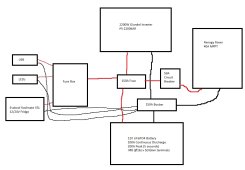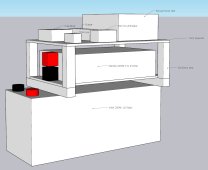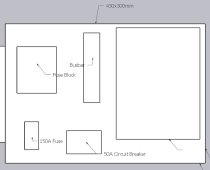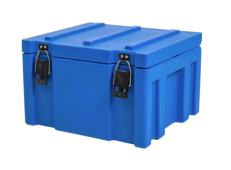thundernanananah
New Member
- Joined
- Dec 14, 2019
- Messages
- 6
I have no experience and this build doesn't have a specific goal. Mostly to gain experience, it looks like fun. I may work up to an off grid solar shed project later.
It's only real practical use will be to go camping. I've already bought the most expensive components (battery, inverter, MPPT) as well as the fuse block, negative busbar and circuit breaker. I'd rather not replace anything unless necessary. Mostly made choices based on specials I got - some parts I've had sitting unused for 6+ months.
I also already have a 12/24V DC + 120/240V AC camping fridge.
The system is massively over-specced. The planned DC appliance draw is never likely to go above 300W. The inverter is there just in case I need AC, no dedicated purposes. I might use my mini Instant Pot on it which doesn't go above 330W while pressure cooking.
I've tried to make it semi portable but it will generally require two people to safely move. It'll be about 30cm wide, 50cm tall and 55cm long at it's maximums. And once put together I'd say about 34-35kg. The battery comes with handles that I intend to use for carrying/moving.


My concerns:
The inverter won't vent well enough. I'm not too worried about the inverter venting 'cause it'll almost always be off and be drawing waaaaay below it's max draw for the brief periods it's on. While my lifelike 3D rendering may fool you into thinking there's no space below the inverter, there is a ~1cm gap.
Protecting the battery and inverter terminals. Having them this close to each other seems like a recipe for a potential short and bad consequences. How can I protect them?
The shunt/monitor seems a waste for such a basic messing about build. I put the MPPT on top so I can see the screen easily and that has a battery voltage monitor. But I'm guessing I should get one.
Not enough space around the busbar/fuse/fusebox/breaker for cabling. Looks pretty cramped. There won't be a tonne of cables but some will be chonky. Since I have no experience it's hard for me to judge. Here's a top down of it, the board is 430x300mm and the area for all that is about half that. Everything measured and to scale:

Thanks to anyone who takes a look.
It's only real practical use will be to go camping. I've already bought the most expensive components (battery, inverter, MPPT) as well as the fuse block, negative busbar and circuit breaker. I'd rather not replace anything unless necessary. Mostly made choices based on specials I got - some parts I've had sitting unused for 6+ months.
I also already have a 12/24V DC + 120/240V AC camping fridge.
The system is massively over-specced. The planned DC appliance draw is never likely to go above 300W. The inverter is there just in case I need AC, no dedicated purposes. I might use my mini Instant Pot on it which doesn't go above 330W while pressure cooking.
I've tried to make it semi portable but it will generally require two people to safely move. It'll be about 30cm wide, 50cm tall and 55cm long at it's maximums. And once put together I'd say about 34-35kg. The battery comes with handles that I intend to use for carrying/moving.


My concerns:
The inverter won't vent well enough. I'm not too worried about the inverter venting 'cause it'll almost always be off and be drawing waaaaay below it's max draw for the brief periods it's on. While my lifelike 3D rendering may fool you into thinking there's no space below the inverter, there is a ~1cm gap.
Protecting the battery and inverter terminals. Having them this close to each other seems like a recipe for a potential short and bad consequences. How can I protect them?
The shunt/monitor seems a waste for such a basic messing about build. I put the MPPT on top so I can see the screen easily and that has a battery voltage monitor. But I'm guessing I should get one.
Not enough space around the busbar/fuse/fusebox/breaker for cabling. Looks pretty cramped. There won't be a tonne of cables but some will be chonky. Since I have no experience it's hard for me to judge. Here's a top down of it, the board is 430x300mm and the area for all that is about half that. Everything measured and to scale:

Thanks to anyone who takes a look.




